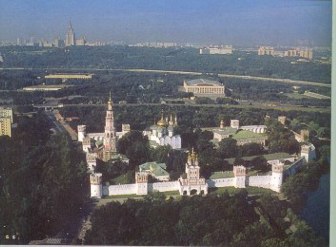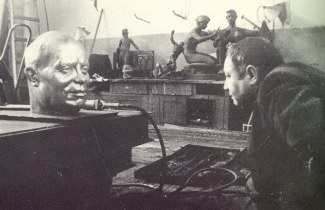|
Click on any picture to enlarge




|
Any visitor to Moscow should include a trip to Novodevichy Convent on their itinery. Situated on a bend in the river Moskva to the south west of the city centre it was built in to honour the reintegration of Smolensk into the Russian State.
It is worth a visit not only for its beautiful ensemble of churches whose golden cupolas and bell towers rise magically above the trees, but also for the adjoining cemetery situated just outside the convent walls. Since the 19th Century it has been the burial place for notable personalities in Russian history and culture, war heroes and eminent statesmen, and their gravestones are quite remarkable.
The writers Chekhov, Mayakovsky, Gogol, Ostrovsky; the composers
Scriabin, Prokoviev and Shostakovich; the directors Stanislavsky and Eisenstein all lie buried here. There are marble sculptures of aeroplanes on the graves of Tupelev and
Ilyushin, but perhaps more impressive is the grave of the inventor of the
Katyusha, the second world war lorry-borne rocket system, depicts one of the trucks firing a salvo - all carved from marble.
The cemetery reopened early in the glasnost era having been closed for many years because the authorities were fearful that an informal shrine may develop around the grave of Nikita Krushchev. Indeed on 14 October each year - the anniversary of his fall from power, the grave is heaped with flowers laid by old men & women who were freed when Krushchev opened the gates of Stalin's Gulag in 1955.
Krushchev was deposed in 1964 and spend seven years in relative obscurity until he died on 13 September 1971. TASS, the Soviet press agency, carried a terse item in which the Central Committee of the Communist Party and the Governement expressed "sorrow" at the the death of "honourary pensioner Krushchev".
The burial service did not take place in the small cemetery just outside the Kremlin walls behind Lenin's mausoleum - the usual site for top party and state leaders, but in Novodevichy cemetery which is reserved for the lesser elite. A simple ceremony was witnessed by about 150 people including Krushchev's immediate family. No Soviet official attended although the Party Central Committee sent an impressive wreath.
The headstone for Krushchev's grave was erected over a year after his death following months of wrangling with the authorities to get permission to build a monument, obtaining the necessary materials (the bronze for the head was declared a strategic resource requiring special permission for its use) and its final construction. Ernst Neizvestny, a renowned Soviet sculptor, was commissioned by the Krushchev family to create a tombstone.
Krushchev's son, Sergei Nikitich, was hesitant to ask Neizvestny because of the famous exchange between Neizvestny and Krushchev in 1962 at the Manezh Exhibition Hall on Manezh Square which did much to destroy the artist's promising career. An exhibition celebrating the 30th anniverary of the founding of the Moscow Artists Union was being held at the Manezh and Krushchev was scheduled to pay a visit.
The organisers, who were champions of Stalinist Socialist Realism, at the last minute arranged to have the work of certain avant-garde artists displayed. They also prepared Krushchev in advance by explaining that their innovative works were bourgeoise, "anti-artistic" and ideologically hostile. They achieved the desired result. Art was not Krushchev's speciality - he was not well informed about it and preferred simple, easily understandable compositions. So when he was faced with this decadent western influenced art he flew into a rage, vociferously condemning modern trends in art and, in typical peasant terms, he likened the exhibition to `dog shit'.
Neizvestny, who was exhibiting at the Manezh, hotly defended modern art and stood his ground insisting Krushchev appoint an independent commission to determine whether or not Neizvestny was competent. Krushchev, who relished an argument but respected alternative opinions that were well argued, calmed down and agreed to appoint a commission, perhaps sensing the weakness of his own argument.
There had been long running feud between Neizvestny and the Moscow Artists Union. He had applied to join the Union at one time but refused to play along with the corruption and underhand operations of the ruling mafia - they responded by trying to crush him. Whilst Neizvestny undoubtedly suffered as a result of the exchange he harboured no ill feeling towards Krushchev - he realised that the whole episode had been set up by the Artists Union mafia.
Describing the concept for the tombstone Neizvestny said:
"In a philosophical sense life itself is based on an antagonism between two principles, one is bright, progressive, dynamic; the other is dark reactionary, static. One strains to move forward, the other pulls back. This basic idea fits Nikita Sergeievich's image quite well. He began to lead our country out o the darkness and he exposed Stalin's crimes. The dawn broke for all of us, heralding the immanent rise of the sun. The light began to dispel the darkness.
This is reflected in the tombstone. The main component is white marble, its dynamic form bearing down on black granite. The darkness resists, struggles, refuses to yield, as with the man himself. It is no accident that the head is on a white pedestal, or that the background remains dark. In the upper corner of the white is a symbolic representation of the sun. Rays extend down from it dispelling darkness.
The head, the colour of old gold on white, not only pleases the eye, it is also a symbol - the Romans immortalised their heroes this way. It all rests on the sturdy foundation of a bronze slab. It can't be budged. There is no resisting the process that's begun."
The artist's signature is on the side of the tombstone and left many bewildered - "Artist: Unknown"(Neizvestny translates as unknown in Russian).
Still persecuted for his art, Ernst Neizvestny finally left the Soviet Union in 1976.
|
Sign
My Guestbook

View
My Guestbook
|
